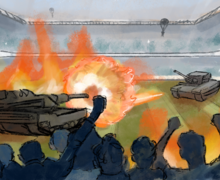Thrifters should be considerate of the poverty within their community
Emily Steinberger | Photo Editor
The Daily Orange is a nonprofit newsroom that receives no funding from Syracuse University. Consider donating today to support our mission.
On the surface, thrift shopping seems like a win-win. You can buy cheap pieces of clothing without buying into fast fashion, one of the newest targets of the zero-waste movement. The environmental impacts of thrifting are valuable, but it is essential that thrifters are aware of poverty in their community. They must avoid purchasing necessities, basics and clothing that could be worn to a job interview, especially while 30.5% of Syracuse residents live in poverty.
Over quarantine, bored teenagers across the country gathered old clothes from their closets and posted them on Instagram accounts. This trend was especially prominent among teenage girls, who created a business network within their communities, making a bit of money and staying connected with those around them. My friends and I made one, from which I earned about $60.
Some accounts became instantly popular, and, to keep the money coming, they did exactly what the free market encouraged them to do ─ be ingenious. These popular accounts would thrift clothing and resell that clothing to their followers for often double the price. One account from Rochester, Lucky Strike Collective, has been involved in the reselling market for at least two years now and has traveled to the Adirondacks and back to find pieces that can sell for around $15 to $75.
For kids like me who grew up wearing thrifted clothing because they had to, this shift can be confusing. Many of us were embarrassed of our thrifted clothes, sometimes even being made fun of for them. But the industry is changing. ThredUP, an online thrift store, shows the incredible potential for the reselling market, which is predicted to be a $36 billion market by 2024, taking over traditional thrift stores as the largest proportion of the secondhand market. These changes will surely help kids like me who need to buy clothes from thrift stores. It is incredible how much more accessible fashion has become as a result of the move towards second hand.
The environmental benefits are also monumental. At fast-fashion stores like Forever21 and Zara, consumers can buy a poorly-made but fashionable outfit that they can wear and then throw away. These companies pollute the environment, and then we do the same by simply throwing things away when we don’t feel like wearing them anymore. Proponents of secondhand clothing also point out that fast fashion is often made in sweatshops overseas, making fashion a human rights and labor issue as well. This was the narrative popular among thrifting enthusiasts on social media, especially as secondhand shopping increased over quarantine.
Just recently, a post began to circulate Instagram stating that these reselling accounts were gentrifying thrift stores and hurting poor people, forcing them to shop through fast-fashion brands. The post resonated with me in its discussion of how individuals that can make a choice to buy second hand are privileged and how all of us must be more aware of how and where we get our clothes.
In reality, 84% of unwanted clothes end up thrown away, even those that make their way to a thrift store. But here in Syracuse, it is important to recognize that there are still much needed items for many people in poverty. In 2018, 44% of Syracuse children lived below the poverty line. For these individuals, winter jackets, business wear, children’s clothing, and basics like socks and bras are especially important.
The good news is that many local resellers are aware of this need and take it into account when looking for clothing to sell. Lauren Levin, a Syracuse University junior who runs Vintage Cuse as well as vintageU, focuses on reselling vintage college apparel. She began by thrifting and auctioning off Syracuse gear through an Instagram account, but when the account became more popular she expanded to vintageU, reselling apparel for countless colleges across the country.
Shopping online keeps resellers from taking too much from one area or store where people need the items. Levin focuses specifically on college apparel, a niche market that mainly targets college students while leaving other necessities for low-income people, especially items like jackets which homeless people depend on.
There is nothing inherently wrong about thrifting. In fact the reality is quite the opposite. Thrifting is beneficial to laborers across the world and to the environment. But next time you go thrifting, remember the people who rely on the clothes you pick through. Leave behind the children’s clothing, the basics, the interview apparel and the jackets. You can afford to buy those elsewhere.
Megan Cooper is a freshman political science and magazine news and digital journalism major. Her column appears bi-weekly. She can be reached at mpcooper@syr.edu.
Published on October 12, 2020 at 9:58 pm






